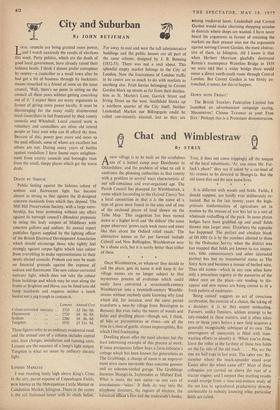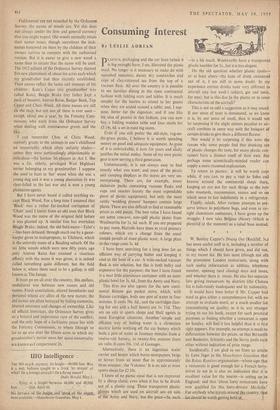Chat and Wirnblestraw
By STRIX
ANEW village is to be built on the scrofulous site of a hutted camp near Dorchester in Oxfordshire, and the problem of what to call it confronts the planning authorities in that county with a problem in several ways characteristic of our self-conscious and over-organised age. The Parish Council has plumped for Wimblestraw, name which (according to the Oxford Times) 'has a local connection in that it is the name of a type of grass once found in the area and of one of the enclosed pieces of land shown on the Tithe Map.' This suggestion has been turned down at a higher level and 'the debate' (the same paper observes) 'grows each week more and more like that about the Oxford relief roads.' The alternative names so far put forward include Colwell and New Bullingdon. Wimblestraw may be a shade arch, but it is surely better than either of these.
* * Once Wimblestraw, or whatever they decide to call the place, gets its name it will keep it; for village names are no longer subject to that mysterious process of evolution which could easily have converted a seventeenth-century Wimblestraw into a twentieth-century Wamble- stream without anybody quite knowing why (and which did, for instance, over the same period transform a near-by village from Bensington to Benson). But even today the names of woods and fields and dwelling places—though not, I think, of hills or promontories or rivers—are all the time in a state of gentle, almost imperceptible, flux which I find fascinating.
Dwelling places offer the most obvious but the least interesting example of this process at work. If some prosperous fellow buys a farm-labourer's cottage which has been known for generations as The Grubbings, a change of name is an improve- ment even more inevitable than concrete gnomes and an asbestos-roofed garage. The Grubbings becomes Shangri-la, Jaybeesden or Mitford End. What is more, the new name—as one says of inoculations—lakes.' It finds its way into the telephone directory, the register of electors, the valuation 'officer's files and the tradesmen's books. True, it does not come trippingly off the tongue of the local inhabitants. 'At., you mean Mr. Fat- lock's place?' they say if asked by a car-load of his cronies to be directed to Shangri-la. But the old name dies and the new name lives.
It is different with woods and fields. Fields, I should suppose, are hardly ever deliberately re- named. But in the last twenty years the high- pressure modernisation of agriculture set in motion by the stresses of war has led to a sort of wholesale reshuffling of the pack. In some places hedges have been grubbed up and small fields thrown into larger ones. Elsewhere the opposite has happened. The perfect and absolute blank of OS 1001 (it is by the numbers allotted to them by the Ordnance Survey when the district was last mapped that fields arc known to tax inspec- tors, tithe commissioners and other interested parties) has lost its immemorial status as The Sixty Acre and becomes a mosaic of barbed wire. Thus old names—which in any case often have only a precarious registry in the memories of the oldest men on the place—are tending to dis- appear and new names are being coined to fit a fresh pattern of enclosures.
'Being coined' suggests an act of conscious cerebration, the exercise of choice, the taking of a decision; it is to that extent misleading. Farmers, unlike foresters, seldom attempt to be tidy-minded in these matters, and it often takes two or three years before a new field acquires a generally recognisable sobriquet of its own. The interregnum of anonymity is filled with time- wasting efforts to identify it. 'When you've done, leave the roller in the farthest of those two fields on the far side of the old track. . . . No, not the one we had rape in last year. The caber one. Re- member where the muck-spreader stood over Easter after the wheel came off?' Most of these colloquies are carried on above the roar of a tractor engine; and I suspect that startling results would emerge from a time-and-motion study of the net loss to agricultural productivity directly attributable to nobody knowing what particular fields are called. Field-names are not recorded by the Ordnance Survey; the names of woods are. Yet this does not always confer the firm and general currency that you might expect. Old woods normally retain their names intact, though sometimes the nick- names bestowed on them by the children of their owners survive to compete with the authorised version. But it is easier to give a new wood a name than to ensure that the name will be used.
The 1912 edition of the Ordnance Survey showed five new plantations of about ten acres each which my grandfather had then recently established.
Their names reflect the tastes and interests of his children : Kate's Copse (my grandmother was called Kate), Beagle Brake (my father kept a pack of bassets), Aintree Raise, Badger Bank, Top Copse and Chats Wood. All these names are still on the map, but not one of them is ever used— except, about one a year, by the Forestry Com- mission, who work from the Ordnance Survey when dealing with maintenance grants and the like.
I can remember Chat, of Chats Wood; memory grants to the animals in one's childhood an immortality which often unfairly eludes— unless they were outstandingly objectionable or ridicUlous—the human bit-players in Act I. She was a fat, elderly, privileged West Highland terrier belonging to my grandmother. I suppose she used to hunt in 'her' wood when she was a young dog and it was a young plantation (it was clear-felled in the last war and is now a young plantation again).
But I have never heard it called anything ex- cept Black Wood. For a long time I assumed that `Black' was a rather far-fetched corruption of `Chats' until I learnt from an old man that Black Wood was the name of the original field before it was planted up. A similar fate has overtaken Beagle Brake; indeed, the old field-name—Tyler's —has been debased, through much use by a game- keeper given to malapropism, to Tilehurst, which is the unlovely name of a Reading suburb. Of the six little woods which were new fifty years ago only Aintree Raise has retained a vicarious affinity with the name it was given; it is indeed called something quite different, but the field below it, where there used to be a gallop, is still known as The Jumps.
It must go on all over the country, this endless, undeclared war between new names and old names. Fresh associations, altered boundaries and personal whims are allies of the new names; the old names are often betrayed by failing memories, blurred utterance and changes of ownership. Like all official historians, the Ordnance Survey gives us a belated and impersonal view of the conflict; and the only hope of a lacklustre peace lies with the Forestry Commission, to whom (though so far to no one else) the fifteen acres to which my grandmother's terrier owes her quasi-immortality are known as Compartment 26.



































 Previous page
Previous page